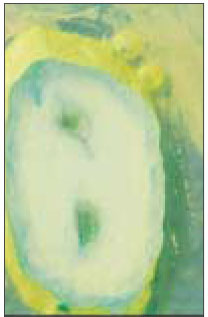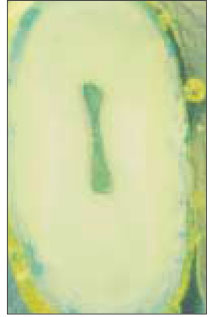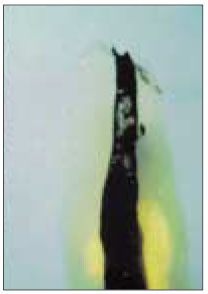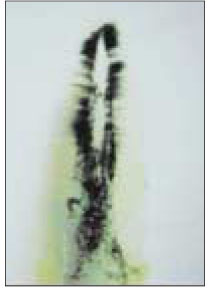The canal system of mandibular incisors
Article information
Abstract
The purpose of this study is to identificate root canal system including ideal access placement, root curvature, canal configuration, incidence of isthmus in mandibular incisors for success of endodontic treatment.
200 mandibular incisors were selected. The ideal access placement was determimed as follows. The teeth were radiographed from mesiodistal and buccolingual views using intraoral dental film. The image was divided into coronal, middle and apical third using the proximal film. Straight line access was determined by measuring the faciolingual canal width and placing points at midway point between the buccal and lingual wall at the junction of the middle and apical third and at the juntion of coronal and middle third of the root canal. A line was drawn connecting these two points extending through the crown of the tooth. The point at which the line crossed the external crown surface was recorded as facial, incisal, lingual. Degree of root curvature was determined by Schneider Protractor Method. Both section method and clearing method were used in this study. By section method, 100 mandibular incisors were embedded in clear resin and transeverse serial sectioned at 0.5, 1.0, 2.0, 3.0, 4.0, 5.0mm level from root apex. The resected surfaces were stained by methylene blue and examined under ×40 magnification with a stereomicroscope. By clearing method, 100 mandibular incisors were cleared in methysalicylate after decalcification with 10% nitric acid and evaluated under ×18 magnification with a stereomicroscope.
The results were as follows ;
1. 29% had the center of the plotted straight-line access facial to incisal edge, whereas 71% had straight-line access at the incisal edge. When incisal wear classified as extensive, the straight-line access was plotted on the incisal edge 95.5%. When incisal wear classified as slight/none, the straight-line access was plotted on the facial 65.9%.
2. Degree of curvature of main canal was straight or almost straight, and only 10% in buccolingual direction had a degree of curvature greater than 20 degrees and 5.5% in mesiodistal direction had.
3. In section method, canal configuration analysis showed that 51% of the specimen classified as type I, 27% as type II, 12% as type III, 10% as type IV. For thoses setions with two canals, the incidence of an isthmus was 26.7%, 64.3%, 79.2%, 96.3%, 97.4%, 97.6% at each level and highest in 3~5mm sections.
4. In clearing method, canal configuration analysis showed that 74% of the specimen classified as type I, 11% as type II, 6% as type III, 9% as type IV.
These results suggested that traditional access from lingual should be moved as far toward the incisal as possible to locate and debride the lingual canal and root canal system should be cleaned, shaped completely and obturated three dimensionally for successful endodontic treatment.



















